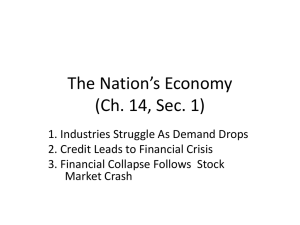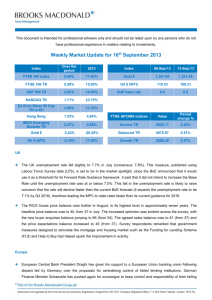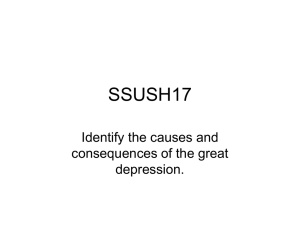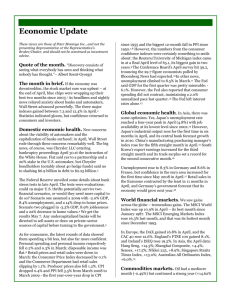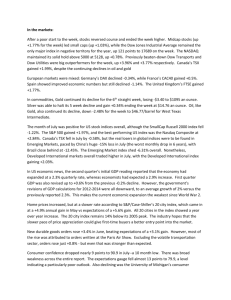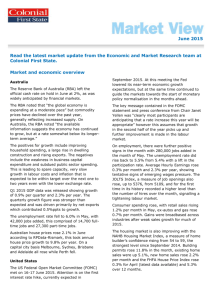Chapter 14 Section 1
advertisement
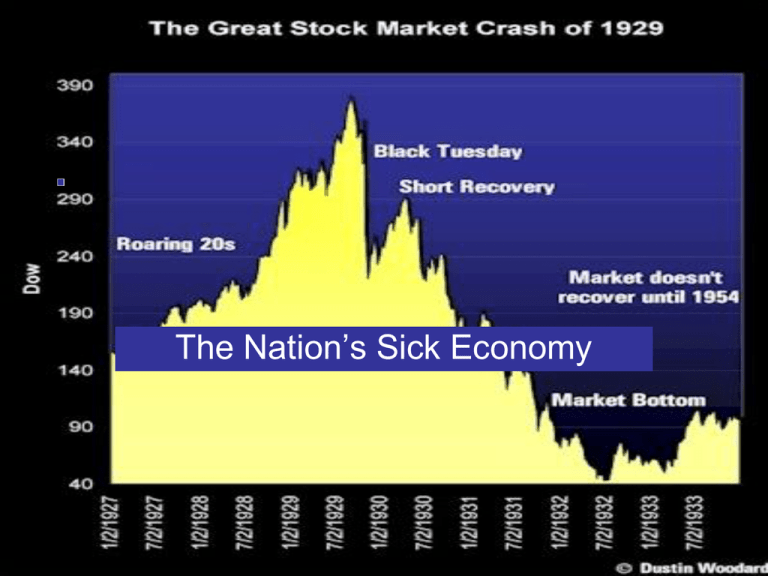
The Nation’s Sick Economy Industries in Trouble • Big industries of • Key industries the 20s began to barely making a weaken- cars, profit construction, consumer goods • Mining and • 1925-29-permits lumbering for new homes fell faced 25% diminished demands • Home construction is an important economic indicator Farmer’s struggling • During warinternational demand for crops soared • Prices rose • Farmers planted more crops & took out loans to buy more land & equipment Farmers struggling • To compensate for falling prices, farmers boosted production • Made things worse • Farm income decreased by $6 billion • Farmers couldn’t pay loans • Lost farms • Rural banks failed • Government wanted to help • Proposed price supports Price Supports • McNary-Haugen bill proposed price supportsthe support of certain prices at or above market value by the government • 1. Govmt would buy surplus crops for more than the market rate • 2. Govmt would sell products to rest of world for less than they were worth • 3. pass tax on domestic food to make up for lost money • Vetoed by President Coolidge twice Consumers Have Less $ to Spend • Farmers income fell • Bought fewer goods • By late 1920sAmericans buying less • Why? – Rising prices – Stagnant wages – Unbalanced distribution of income – Overbuying on credit Living on Credit • People living beyond their means • Credit-buy now, pay later –Installment plan – Americans piling up large debt – People cut back spending Uneven Distribution of Income • Incomes not raising fast enough • 1920s-half nation’s families earned $1,500/year • 1920-1929 income of wealthiest 1% rose 75% • American wages as a whole rose 9% • 1929-wealthiest 5% took in 33% of nations income • Poorest 40% earned just over 10% New President • Herbert Hoover • Americans desired to continue prosperity they experienced under Republican administrations President Hoover The Stock Market Comes Tumbling Down • BY 1929-many economists warning of weakness of the stock market • Most people had no idea there was a problem • People continued to invest in the stock market Dreams of Riches in the Stock Market • Throughout 20sstock prices rose steadily • Many Americans rushed to buy stocks • Many Americans hoping to get rich Dreams of Riches in the Stock Market • Many investors engaged in speculation – Made stock prices rise • Made businesses look worth more than they were Dreams of Riches in the Stock Market • Many investors also began buying on margin • This worked as long as prices rose • If stocks declined there was no way to pay off the loan Black Tuesday • October 29, 1929The bottom fell out of the stock market • Known as Black Tuesday • People and businesses tried to sell stocks before prices fell further Black Tuesday • People who bought stock on credit acquired huge debts • Within weeks investors had lost $30billion Causes of the Great Depression • • • • Old and decaying industrial base Crisis in the farm sector Easy credit Unequal distribution of income Financial Collapse • People panicked and withdrew all their money from banks • Many banks lost their money in bad investments • 659 banks closed in 1929 Financial Collapse • By 1933-6,000 banks had closed • Wiped out 9 million individual savings accounts • 85,000 businesses went bankrupt Financial Collapse • Unemployment rose from 3% in 1929 to 25% in 1933 • Many that kept their job had to take a pay cut Worldwide Shock Waves • Congress makes things worse • Pass Hawley-Smoot Tariff Act-highest tariff in U.S. History • Supposed to help Americans from foreign competition Worldwide Shock Waves • Hawley Smoot Tariff Act- Reduced flow of good into the U.S. – Prevented other countries from earning American currency • Could not buy American exports – Made unemployment worse Worldwide Shock Waves • Many European countries retaliated by raising their own tariffs • Caused world trade to reduce by more than 40%
